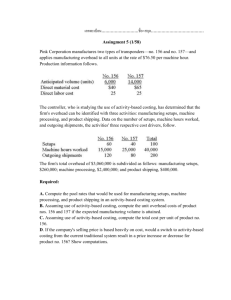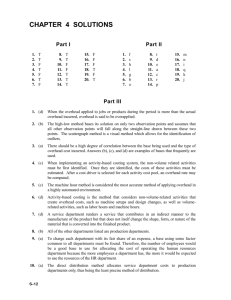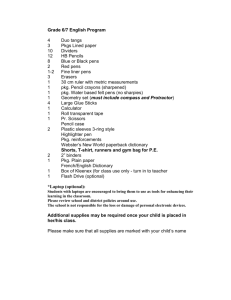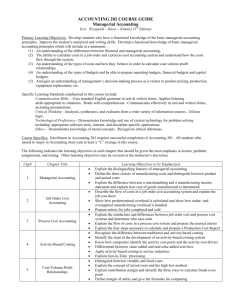Measure Costs Right: Make the Right Decisians
advertisement
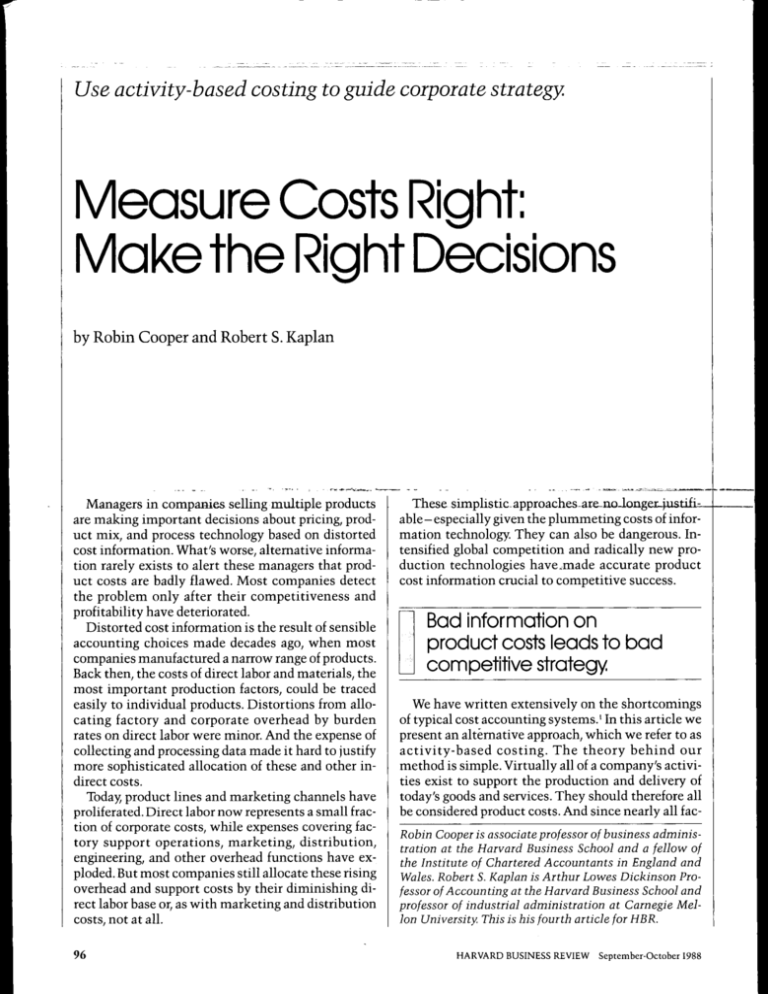
Use activity-based costing to guide corporate strategy. Measure Costs Right: Make the Right Decisians by Robin Cooper and Robert S. Kaplan Managers in companies selling multiple products are making important decisions about pricing, product mix, and process technology based on distorted cost information. What's worse, alternative information rarely exists to alert these managers that product costs are badly flawed. Most companies detect the problem only after their competitiveness and profitability have deteriorated. Distorted cost information is the result of sensible accounting choices made decades ago, when most companies manufactured a narrow range of products. Back then, the costs of direct labor and materials, the most important production factors, could be traced easily to individual products. Distortions from allocating factory and corporate overhead by burden rates on direct labor were minor. And the expense of collecting and processing data made it hard to justify more sophisticated allocation of these and other indirect costs. Today, product lines and marketing channels have proliferated. Direct labor now represents a small fraction of corporate costs, while expenses covering factory support operations, marketing, distribution, engineering, and other overhead functions have exploded. But most companies still allocate these rising overhead and support costs by their diminishing direct labor base or, as with marketing and distribution costs, not at all. 96 These simplistic- approaches-are-noJ.origer4iistifi:^ able - especially given the plummeting costs of information technology. They can also be dangerous. Intensified global competition and radically new production technologies have.made accurate product cost information crucial to competitive success. Bad information on product costs ieads to bad competitive strategy We have written extensively on the shortcomings of typical cost accounting systems.' In this article we present an alternative approach, which we refer to as activity-based costing. The theory behind our method is simple. Virtually all of a company's activities exist to support the production and delivery of today's goods and services. They should therefore all be considered product costs. And since nearly all facRobin Cooper is associate professor of business administiation at the Harvard Business School and a fellow of the Institute of Chartered Accountants in England and Wales. Robert S. Kaplan is Arthur Lowes Dickinson Professor of Accounting at the Harvard Business School and professor of industrial administration at Carnegie Mellon University. This is his fourth article for HBR. HARVARD BUSINESS REVIEW September-October 1988 tory and corporate support costs are divisible or separable, they can be split apart and traced to individual products or product families. These costs include: Logistics Production Marketing and Sales Distribution Service Technology Financial Administration Information Resources General Administration Conventional economics and management accounting treat costs as variable only if they change with short-term fluctuations in output. We (and others) have found that many important cost categories vary not with short-term changes in output but with changes over a period of years in the design, mix, and range of a company's products and customers. An effective system to measure product costs must identify and assign to products these costs of complexity. Many managers understand intuitively that their accounting systems distort product costs, so they make informal adjustments to compensate. But few can predict the magnitude and impact of the adjustments they should be making. Consider the experience of a leading manufacturer of hydraulic valves whose product line included thousands of items. About 20% of the valves generated 80% of total revenues, a typical ratio for multiproduct organizations. Of even greater interest, 60% of the products generated 99% of the revenues. Nonetheless, management remained enthusiastic about the 40% of its products that generated only 1% of revenues. According to its cost system, these specialty items had the best gross margins. An analysis using activity-based costing told a very different story. More than 75% of this company's products (mostly the low-volume items) were losing money. The products that did make money (fewer than one in four) generated more than 80% of sales and 300% of net profits. Top executives may be understandably reluctant to abandon existing product cost systems in favor of a new approach that reflects a radically different philosophy. We do not advocate such an abrupt overhaul. The availability of cheap, powerful personal computers, spread sheets, and data-base languages allows businesses to develop new cost systems for strate1. See Robert S. Kaplan and H. Thomas Johnson, Relevance Lost: The Rise and Fall of Management Accounting (Boston: Harvard Business School Press, 1987) and Robin Cooper and Robert S. Kaplan, "How Cost Accounting Distorts Product Costs," Management Accounting, April 1988, p. 20. HARVARD BUSINESS REVIEW September-October 1988 gic purposes off-line from official accounting systems. Companies don't have to commit their entire accounting system to activity-based costing to use it. Indeed, activity-based costing is as much a tool of corporate strategy as it is a formal accounting system. Decisions about pricing, marketing, product design, and mix are among the most important ones managers make. None of them can be made effectively without accurate knowledge of product costs. What Distorts Cost Data? Product cost distortions occur in virtually all organizations producing and selling multiple products or services. To understand why, consider two hypothetical plants turning out a simple product, ballpoint pens. The factories are the same size and have the same capital equipment. Every year Plant I makes one million blue pens. Plant II also produces blue pens, but only 100,000 per year. To fill the plant, keep the work force busy, and absorb fixed costs. Plant II also produces a variety of similar products: 60,000 black pens, 12,000 red pens, 10,000 lavender pens, and so on. In a typical year. Plant II produces up to 1,000 product variations with volumes ranging between 500 and 100,000 units. Its aggregate annual output equals the one million units of Plant I, and it requires the same total standard direct labor hours, machine hours, and direct material. Despite the similarities in product and total output, a visitor walking through the two plants would notice dramatic differences. Plant II would have a much larger production support staff-more people to schedule machines, perform setups, inspect items after setup, receive and inspect incoming materials and parts, move inventory, assemble and ship orders, expedite orders, rework defective items, design and implement engineering change orders, negotiate with vendors, schedule materials and parts receipts, and update and program the much larger computerbased information system. Plant II would also operate with considerably higher levels of idle time, overtime, inventory, rework, and scrap. Plant II's extensive factory support resources and production inefficiencies generate cost-system distortions. Most companies allocate factory support costs in a two-step process. First, they collect the costs into categories that correspond to responsibility centers (production control, quality assurance, receiving) and assign these costs to operating departments. Many companies do this first step very well. But the second step - tracing costs from the operating departments to specific products-is done sim97 MEASURING COSTS plistically. Many companies still use direct labor hours as an allocation base. Others, recognizing the declining role of direct labor, use two additional allocation bases. Materials-related expenses (costs to purchase, receive, inspect, and store materials) are allocated directly to products as a percentage markup over direct materials costs. And machine hours, or processing time, are used to allocate production costs in highly automated environments. Whether Plant II uses one or all of these approaches, its cost system invariably-and mistakenly-reports production costs for the high-volume product (blue pens) that greatly exceed the costs for the same product built in Plant I. One does not need to know much about the cost system or the production process in Plant II to predict that blue pens, which represent 10% of output, will have about 10% of the factory costs allocated to them. Similarly, lavender pens, which represent 1% of Plant II's output, will have about 1% of the factory's costs allocated to them. In fact, if the standard output per unit of direct labor hours, machine hours, and materials quantities are the same for blue pens as for lavender pens, the two types of pens will have identical reported costs Existing cost systems frequently understate profits on iiigh-volume products and overstate profits on speoiaity items. - even though lavender pens, which are ordered, fabricated, packaged, and shipped in much lower volumes, consume far more overhead per unit. Think of the strategic consequences. Over time, the market price for blue pens, as for most highvolume products, will be determined by focused and efficient producers like Plant I. Managers of Plant II will notice that their profit margin on blue pens is lower than on their specialty products. The price for blue pens is lower than for lavender pens, but the cost system reports that blue pens are as expensive to make as the lavender. While disappointed with the low margins on blue pens. Plant II's managers are pleased they're a fullline producer. Customers are willing to pay premiums for specialty products like lavender pens, which are apparently no more expensive to make than commodity-type blue pens. The logical strategic response? De-emphasize blue pens and offer an expanded line of differentiated products with unique features and options. 98 In reality, of course, this strategy will be disastrous. Blue pens in Plant II are cheaper to make than lavender pens-no matter what the cost system reports. Scaling back on blue pens and replacing the lost output by adding new models will further increase overhead. Plant II's managers will simmer with frustration as total costs rise and profitability goals remain elusive. An activity-based cost system would not generate distorted information and misguided strategic signals of this sort. Designing an Activity-Based Cost System The first step in designing a new product cost system is to collect accurate data on direct labor and materials costs. Next, examine the demands made by particular products on indirect resources. Three rules should guide this process: 1. Focus on expensive resources. 2. Emphasize resources whose consumption varies significantly by product and product type,- look for diversity. 3. Focus on resources whose demand pattems are uncorrelated with traditional allocation measures like direct labor, processing time, and materials. Rule 1 leads us to resource categories where the new costing process has the potential to make big differences in product costs. A company that makes industrial goods with a high ratio of factory costs to total costs will want a system that emphasizes tracing manufacturing overhead to products. A consumer goods producer will want to analyze its marketing, distribution, and service costs by product lines, channels, customers, and regions. Hightechnology companies must study the demands made on engineering, product improvement, and process development resources by their different products and product lines. Rules 2 and 3 identify resources with the greatest potential for distortion under traditional systems. They point to activities for which the usual surrogates-labor hours, material quantities, or machine hours-do not represent adequate measures of resource consumption. The central question is, which parts of the organization tend to grow as the company increases the diversity of its product line, its processing technologies, its customer base, its marketing channels, its supplier base? The process of tracing costs, first from resources to activities and then from activities to specific products, carmot be done with surgical precision. We cannot estimate to four significant digits the added HARVARD BUSINESS REVIEW September-October 1988 MEASURING COSTS burden on support resources of introducing two new variations of a product. But it is better to be basically correct with activity-based costing, say, within 5% or 10% of the actual demands a product makes on organizational resources, than to be precisely wrong (perhaps by as much as 200%) using outdated allocation techniques. The insert "Allocating Costs under an ActivityBased System" shows how a company might calculate and assign the support costs of a common manufacturing overhead function-raw materials and parts control. The principles and methods, while illustrated in a conventional manufacturing setting, are applicable to any significant collection of corporate resources in the manufacturing or service sector. The Impact of Activity-Based Costing An activity-based system can paint a picture of product costs radically different from data generated by traditional systems. These differences arise because of the system's more sophisticated approach to attributing factory overhead, corporate overhead, and other organizational resources, first to activities and then to the products that create demand for these indirect resources. Manufacturing Overhead. Let's look more closely at the manufacturer of hydraulic valves mentioned earlier. Cost information on seven representative products is presented in the table "How ActivityBased Costing Changes Product Profitability," Under the old cost system, the overhead charge per unit did not differ much among the seven valves, ranging from $5,34 to $8.88. Under the new system, which traces overhead costs directly to factory support activities and then to products, the range in overhead cost per unit widened dramatically-from $4.39 to $77.64, With four low- to medium-volume products (valves 2 through 5), the overhead cost estimate increased by 100% or more. For the two highest volume products (valves 1 and 6), the overhead cost declined. The strategic consequences of these data are enormous. Under the labor-based cost system, valve 3was considered the most profitable product of the seven, with a gross margin of 47%, The activitybased system, in contrast, revealed that when orders for valve 3 arrived, the company would have done better to mail its customers cash to buy the valves elsewhere than to make them itself. Labor-based cost systems don't always underestimate the overhead demands of low-volume products. 100 Valve 7, with the second lowest volume in the group, shows a marked decrease in overhead under an activity-based system. Why? Valve 7 is assembled from components already being used on the highvolume products (valves 1 and 6), The bulk of any factory's overhead costs are associated with ordering parts, keeping track of them, inspecting them, and setting up to produce components. For parts and components ordered or fabricated in large volumes, the per-unit impact of these transaction costs is modest. Therefore, specialized products assembled from high-volume components will have low production costs even if shipping volume is not high. Marketing Expenses. The redesign of cost systems should not be limited to factory support costs. Many companies have selling, general, and administrative (SG&A) expenses that exceed 20% of total revenues. Yet they treat these costs as period expenses, not charges to be allocated to products. While such "below the [gross margin] line" treatment may be adequate, even required, for financial accounting, it is poor practice for measuring product costs. We studied a building supplies company that distributed its products through six channels-two in the consumer market and four in the commercial market. Across all its products, this company had an average gross margin of 34%. Marketing costs for the six channels averaged 16.4% of sales, with general and administrative expenses another 8,5%, (The tables entitled "OEM Changes from a Laggard...to a Solid Performer" present information on the four corrmiercial charmels.) With operating profits in the commercial sector at only about 10% of revenues, the company was look- iVIanagennent thought vaive 3 was a cash cow. It might as well have mailed checks to its customers. ing to improve its profitability. Management decided to focus on SG&A expenses. Previously, the company had allocated SG&A costs by assigning 25% of sales - t h e company average-to each distribution segment, A more sophisticated analysis, similar in philosophy to the overhead analysis performed by the hydraulic valve company, produced striking changes in product costs. T'he OEM business was originally a prime target for elimination. Its 27% gross margin and laggard 2% operating margin put it at the bottom of the pack among commercial channels. But the OEM channel HARVARD BUSINESS REVIEW September-October 1988 How Activity-Based Costing Changes Product Profitability Manufacturing Overhead Per Unit Gross Margin Valve Number Annual Volume (units) Old System New System Percent Difference Old System New System 1 2 3 4 5 6 7 43,562 500 53 2,079 5,670 11,196 423 $5.44 6.15 7.30 8.88 7.58 5.34 5.92 $ 4.76 12.86 77.64 19.76 15.17 5.26 4.39 - 12.5% -1-109.0 -1-964.0 +123.0 -f-100.0 1.5 - 26.0 41% 30 47 26 39 41 31 46% - 24 -258 - 32 2 41 43 *We are not confident that the table's figures are exactly conect. For example, students of this case have estimated the appropriate overhead charge on valve 3 |listed at $77.64 per unit| to he as low as $64 and as high as $84. Whatever the exact figure, the difference between this activity-based cost and the original estimate ($7.30 per unit) suggests that the ciirrent labor-based system is seriously flawed. used virtually no resources in several major selling categories: advertising, catalog, sales promotion, and warranty. In the remaining selling categories, the OEM channel used proportionately fewer resources per sales dollar than the other major channels. Its marketing expenses were 9% of sales, well helow the 15% average for the four commercial channels. A sounder estimate of OEM operating margin was 9%, not 2%. The OEM segment looked even hetter after the company extended the analysis hy allocating invested capital to specific channels. The OEM business required far less investment in working capital-accounts receivable and inventory-than the other commercial channels. Thus, even though the OEM channel had a helow-average gross margin, its hottom-line retum-on-investment tumed out to he higher than the commercial average. Othei Coipoiate Overhead. Virtually all organizational costs, not just factory overhead or marketing expenses, can and should he traced to the activities for which these resources are used, and then to the divisions, channels, and product lines that consume them. Weyerhaeuser Company recently instituted a charge-hack system to trace corporate overhead department costs to the activities that drive them.^ For example, Weyerhaeuser's financial services department analyzed all the activities it performedincluding data-hase administration, general accounting, accounts payable and receivable, and invoici n g - t o determine what factors create demands for them. A division dealing with a small numher 2. See H. Thomas Johnson and Dennis A. Loewe, "How Weyerhaeuser Manages Corporate Overhead Costs," Management Accounting, August 1987, p. 20. HARVARD BUSINESS REVIEW September-October 1988 of high-volume customers makes very different demands on activities like accounts receivable from a division with many low-volume customers. Before instituting the charge-hack system, Weyerhaeuser applied the cost of accounts receivahle and other functions as a uniform percentage of a division's sales-a driver that hore little or no relation to the activities that created the administrative work. Now it allocates costs hased on which divisions (and product lines) generate the costs. Similarly, companies engaged in major product development and process improvements should attribute the costs of design and engineering resources to the products and product lines that benefit from them. Otherwise, product and process modification costs will he shifted onto product lines for which little development effort is heing performed. Where Does Activity-Based Costing Stop? We believe that only two types of costs should be excluded from a system of activity-based costing. First, the costs of excess capacity should not he charged to individual products. To use a simplified example, consider a one-product plant whose practical production capacity is one million units per year. The plant's total annual costs amount to $5 million. At full capacity the cost per unit is $5. This is the unit product cost the company should use regardless of the plant's hudgeted production volume. The cost of excess or idle capacity should be treated as a separate line item-a cost of the period, not of individual products. 101 MEASURING COSTS OEM Changesfroma Laggard... Profits by Commercial Distribution Channel (Old System) Contract Annual Sales Industrial Suppliers Government OEM Tbtal Commercial $422 $9,200 $114,166 23% 27% 35% $136 $2,461 $ 40,256 (in thousands of dollars) $79,434 Gross Margin Gross Profit SG&A Allowance* $27,375 $25,110 41% $10,284 (in thousands of dollars) $19,746 $ 6,242 $105 $2,287 $ 31,814 $ 7,629 $ 4,042 $ 31 $ 174 $ 11,876 34% Operating Profit (in thousands of dollars) Operating Margin Invested Capital Allowancet (in thousands of dollars) Return on Investment 10% 16% $33,609 23% $10,624 38% 7% 2% 10% $179 $3,893 $ 48,305 17% 4% 25% *SG&A allowance for each channel is 25% of that channel's revenues, tinvested capital allowance for each channel is 42% of that channel's revenues. Many companies, however, spread capacity costs over budgeted volume. Returning to our example, if demand exists for only 500,000 units, a traditional cost system will report that each unit cost $10 to build ($5 million/500,000) even though workers and machines have become no less efficient in terms of what they could produce. Such a procedure causes product costs to fluctuate erratically with changes in assumed production volume and can lead to the "death spiral." A downturn in forecast demand creates idle capacity. The cost system reports higher costs. So management raises prices, which guarantees even less demand in the future and still higher idle capacity costs. The second exclusion from an activity-based cost system is research and development for entirely new products and lines. We recommend splitting R&D costs into two categories: those that relate to improvements and modifications of existing products and lines and those that relate to entirely new products. The first category can and should be traced to the products that will benefit from the development effort. Otherwise, the costs will he spread to products and lines that bear no relationship to the applied R&JD program. The second category is a different animal. Financial accounting treats RSUD as a cost of the period in which it takes place. The management accounting system, in contrast, should treat these costs as investments in the future. Companies engaged in extensive R&D for products with short life cycles should measure costs and revenues over the life cycle of their products. Any periodic assessment of product 102 profitability will be misleading, since it depends on the arbitrary amortization of investment expenditures including R&X). Strategic Implications The examples we've discussed demonstrate how an activity-based cost system can lead to radically different evaluations of product costs and profitability than more simplistic approaches. It does not imply that because some low-volume products (lavender pens or valve 3) now are unprofitable, a company should immediately drop them. Many customers value having a single source of supply, a big reason companies become full-line producers. It may be impossible to cherry pick a line and build only profitable products. If the multiproduct pen company wants to sell its profitable blue and black pens, it may have to absorb the costs of filling the occasional order for lavender pens. Once executives are armed with more reliable cost information, they can ponder a range of strategic options. Dropping unprofitable products is one. So is raising prices, perhaps drastically. Many low-volume products have surprisingly low price elasticities. Customers who want lavender pens or valve 3 may be willing to pay much more than the current price. On the other hand, these customers may also react to a price increase by switching away from low-volume products. That too is acceptable; the company would be supplying fewer money-losing items. HARVARD BUSINESS REVIEW September-October 1988 ...to a Solid Performer Profits by Commercial Distribution Channel (New System) Gross Profit (from previous table) Contract Industrial Suppliers Government OEM Tbtal Commercial $27,375 $10,284 $136 $2,461 $40,256 $ 4,682 132 504 416 394 64 5,696 892 $12,780 $ 6,740 $ 1,344 38 160 120 114 22 1,714 252 $ 3,764 $ 2,131 $ 12 0 0 0 0 0 20 12 $ 44 $ 36 $ 372 2 0 0 2 4 351 114 $ 845 $ 781 $ 6,410 172 664 536 510 90 7,781 1,270 $17,433 $ 9,688 $ 7,855 10% $33,154 24% $ 4,389 17% $10,974 40% $ 56 13% $184 30% $ 835 9% $2,748 30% $13,135 12% $47,060 28% Selling Expenses* (all in thousands of dollars) Commission Advertising Catalog Co-op Advertising Sales Promotion Warranty Sales Administration Cash Discount Total G&A (in thousands of dollars) Operating Profit (in thousands of dollars) Operating Margin Invested Capital* Return on Investment *Selling expenses and invested capital estimated under an activity-based system. More accurate cost information also raises strategic options for high-volume products. Plant n might consider dropping its prices on hlue pens. The old cost system, which shifted overhead charges onto these high-volume products, created a price umbrella that benefited focused competitors like Plant I. Pricing its core product more competitively might help Plant n reverse a market-share slide. Managers in the building supplies company we described took several profit-enhancing steps after receiving the revised cost data by distribution channels. They began emphasizing the newly attractive OEM segment and any new business where marketing costs would be well below the company average. Information generated by an activity-based cost system can also encourage companies to redesign products to use more common parts. Managers frequently exhort their engineers to design or modify products so they use fewer parts and are easier to manufacture. But these exhortations will ring hollow if the company's cost system cannot identify the benefits to design and manufacturing simplicity. Recall valve 7, a low-volume product made from components fabricated in large volumes for other products. Now that the company can quantify, using activity-based techniques, the impressive cost beneHARVARD BUSINESS REVIEW September-October 1988 fits of component standardization, the entire organization will better understand the value of designing products for manufacturability. Likewise, activity-based costing can change how managers evaluate new process technologies. Streamlining the manufacturing process to reduce setup times, rationalizing plant layout to lower material handling costs, and improving quality to reduce postproduction inspections can all have major impacts on product costs-impacts that become visible on a product-by-product basis with activity-based costing. A more accurate imderstanding of the costs of specialized products may also make computerintegrated manufacturing (CIM) look more attractive, since CIM is most efficient in high-variety, low-volume envirorunents. Activity-based costing is not designed to trigger automatic decisions. It is designed to provide more accurate information about production and support activities and product costs so that management can focus its attention on the products and processes with the most leverage for increasing profits. It helps managers make better decisions about product design, pricing, marketing, and mix, and encourages continual operating improvements. ^ Reprint 88503 103


